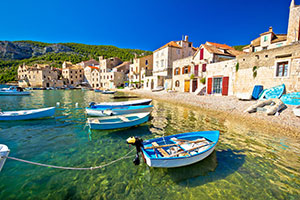Istanbul
Istanbul
This centuries old capital guards the slender waterway between the Mediterranean and the Black Sea, and is the doorway between the East and West. Visitors can explore remnants of Byzantine Constantinople in the Sultanahmet district, where you will have the chance to see ancient splendors, such as the Haghia Sophia, the Blue Mosque and Topkapi Palace. At night the city boast a lively nightclub scene and excellent Turkish dining options that may include cultural entertainment and dancing. Istanbul also features splendid shopping malls, boutiques, and hand crafted items can be found all over the city.
|
Destination Guide
|
Mostar
Mostar
Mostar is a small historic town in southwestern Bosnia, surrounded on three sides by rugged mountains. Mostar is Bosnia's most famous and popular destination, mainly because of its impressive Ottoman-era historic district and famous Ottoman-built arched stone bridge over the Neretva River gorge. Although quite small, Mostar is the capital of the Herzegovina district. Since Mostar lies on the trading route between the Adriatic Sea and mineral-rich Bosnian lands, the site was occupied for many centuries prior to Ottoman rule of the region. However, it was the Ottoman Turks who established the present-day town when taking control of the region in 1468. They began building many Ottoman-style buildings, Turkish-style mosques and large private mansions for wealthy citizens. Their most-acclaimed architectural structure is the arched stone bridge, Stari Most, built in 1566. Like nearly every town and city in Bosnia, Mostar was badly damaged by the 1990s regional wars. Many historic mansions and buildings, private homes and all of Mostar's bridges were completely destroyed. A major incident in Mostar took place in 1993, when Bosnian Croats began a 10-month siege of the Muslim quarter of the city, rendering its landmark, stone-arch bridge, Stari Most, and mosques to rubble. Fortunately, Mostar has been able to rebuild, in great part thanks to various international organizations and governments contributions. The reconstruction of Stari Most (the Old Bridge) has been completed and it is well worth a visit. On the other hand, many large buildings have been left in states of destruction, complete with bullet and grenade holes, providing a stark reminder of the devastation. Rebuilding of the city continues, and tourists are warmly welcomed. The annual bridge jumping competition from Stari Most into the Neretva River below is famous throughout the regions. Having taken place for more than four centuries, this competition attracts both swimmers and spectators from all over Europe.
|
Destination Guide
|
Sarajevo
Sarajevo
Sarajevo is one of the most historically interesting cities in Europe. It is the place where the Western & Eastern Roman Empire split; where the people of the Eastern Orthodox east, the Ottoman south and the Roman Catholic west, met, lived and warred. It has been both an example of historical turbulence and the clash of civilizations, as well as a beacon of hope for peace and tolerance through multi-cultural integration.
Today the city has physically recovered from most of the war damage caused by the Yugoslav Wars of the early nineties. Sarajevo is a cosmopolitan European capital with a unique Eastern twist that is a delight to visit. The people are very friendly, be they Bosniak, Serb, or Croat. There is very little crime, not nearly as many tourists as on the Dalmatian coast and a wealth of architecture (not to mention history) to see.
|
Destination Guide
|
Plovdiv
Plovdiv
Situated on the Maritsa River, Plovdiv is the second largest city in Bulgaria. Older than Rome, Athens, Carthage or Constantinople, it is almost a contemporary of Troy. Set upon ancient crossroads, the city has hints of both East and West civilizations that add spice to her people and stimulate a unique cultural identity. Look closely around the city to see glimpses of Thracian, Macedonian, Byzantium, and Ottoman influences. Visitors take days to wander around the towns many parks, gardens, museums and historical monuments. The Ancient Theatre (which is a Roman theatre), is one of the most remarkable sites and maybe while you’re visiting you will be able to catch a performance in the theatre. This city is the place to be in Bulgaria, most times rivaling the capital Sofia.
|
Destination Guide
|
Sofia
Sofia
Sofia is capital of Bulgaria with a motto “Ever growing, never aging". Influences of many different cultures can be spotted through the city. Alexander Nevski Memorial Church has a gold dome considered one of the finest pieces of architecture in the Balkans. Other points of interest include 4th-6th century Church of St. Sofia; Boyana Church, a good example of 11th century East European Medieval art; and 15th century Dragalevtsi monastery. The National Palace of Culture is the Balkans' biggest congress center. Vassil Levski monument is where the main architect of the campaign to free Bulgaria from oppression of the Ottoman Empire was hanged by Turks in 1873. The National History Museum, Archaeological Museum and National Natural History Museum are there. There are many areas around downtown for nightlife. Sofia sits near Mount Vitosha and during the winter months this is a prime skiing spot.
|
Destination Guide
|
Skopje
Skopje
The capital and modern city of Skopje has everything that any other capital city can offer—fabulous churches, mosques, excellent museums, galleries, shopping, concerts, theater, opera, ballet and even casinos—but all on a smaller scale. And one of its greatest highlights is the biggest and oldest Turkish bazaar in Europe, originally rivaling the one in old Baghdad. Skopje sits on the banks of the Vardar River, and much of its modernity is the result of an earthquake that leveled large sections of the city in 1963—the clock in the railway station has been preserved, forever stopped at 5:17 am, the moment when the quake struck. Fortunately for visitors, much of the old town survived. Cross the 11 arches of the Stone Bridge, built by the Turks in the 1400s, and you will find cultural and historical monuments that span centuries. Especially notable are the 15th-century Daud Pasha Turkish Baths, the largest in the region. But don't plan on getting your feet wet—today, the City Art Gallery occupies the premises. For a nice overview of the city, climb to the Kale Fortress, a ruined castle. Then visit the nearby Church of Sveti Spas (note the beautiful iconostasis). In the Mosque of Mustafa Pasha, look for the cracked dome caused by an earthquake. A day trip can also be made to man-made Lake Matka, where you'll find a fantastic 22-mi/35-km canyon with a cliff-side footpath and numerous old churches surrounding the lake. There is also swimming, hiking, canoeing, climbing, cave exploring and great seafood restaurants there. Ohrid or Stobi, a colorful ancient town on the road to Greece, are also good day trips from Skopje. 120 mi/195 km northeast of Ohrid.
|
Destination Guide
|
Belgrade
Belgrade
Belgrade is the capital of Serbia with about 1.6 million inhabitants. It is located in southeast Europe, in the Balkan Peninsula, at the confluence of the Sava and Danube rivers. It is one of the oldest cities in Europe and since ancient times it has been an important traffic focal point, an intersection of the roads of Eastern and Western Europe. Belgrade is the capital of Serbian culture, education, science and economy. As a result of its tumultuous history, many nations live in Belgrade for centuries, and the majority of the population make Serbs (86%) of Orthodox persuasion.
|
Destination Guide
|
Dubrovnik
Dubrovnik
Classed as a world heritage treasure by UNESCO, Dubrovnik is a place of ancient streets lined with stone palaces, Venetian-style buildings and bell towers. The city is enclosed by stone walls, and the highlight is a leisurely walk atop these massive walls for a great view of the city and the sea. Entering Dubrovnik, you are greeted by an impressive pedestrian promenade, the Placa, which extends before you all the way to the clock tower at the other end of town. The Orlando Tower here is a favorite meeting place. Just inside the city walls near the Pile Gate is the Franciscan Monastery housing the third-oldest functioning pharmacy in Europe, operating since 1391. For a fantastic panorama of the city, take a cable car ride to the summit of the 1,340-foot Mount Srdj.
|
Destination Guide
|
Ljubljana
Ljubljana
This charming, inexpensive city with its relaxed pace, active cafe life and fondness for poets could be "the next Prague" with its own distinctive character. Several remaining structures show Roman and Baroque influences. The heart of the city lies on both sides of the Ljubljanica River. Over time, architects have used the Ljubljanica as an opportunity to build a handful of tasteful bridges. On one side of the river are the narrow cobblestone streets of the old town, which sits in the shadow of Ljubljana Castle. On the other side of the Ljubljanica is Tivoli castle, a graphic arts center, and the main shopping streets, lined by graceful art-nouveau buildings. The ultramodern Cultural and Congress Center, near the neo-rococo Opera House, is the setting for cultural performances. Worth seeing are the Franciscan Church and the Baroque town hall, with its monumental fountain. Hike to the top of 3,600-ft Mt. Katarina from Ljubljana. A trail begins in the suburb of Podutik before winding through spruce forests and up to a small church at the mountain's peak.
|
Destination Guide
|
Trieste
Trieste
Trieste is an interesting city and a flourishing center of trade and commerce. It was a literary and cultural center in the 20th century, and the town has Viennese influence and style - along with grand squares, palazzi and churches. The main square, Piazza dell'Unita d'Italia, has Viennese cafes, Palazzo del Governo, and Palazzo del Comune with its clock tower. All of these buildings were built in the 19th century. The promenade is a worth a stroll. Upper town, Colle di San Giusto - with its terrific views - has beautiful Castello di San Giusto and its musuem at the top of the hill, Piazza Cattedrale. Basilica di San Giusto is two churches in several styles, including Roman and Byzantine, with frescoes depicting San Giusto (the town's patron saint), mosaics, and the lovely rose window. The civic museum here has art, religious items and historical items inside. Orto Lapidario displays pottery and statues. Visit Civico Museo Revoltella. Stop at Castello di Miramare and her gardens. Villa Opicina has a wonderful belvedere and views, and Grotta Gigante is an amazing walkable cave museum.
|
Destination Guide
|
Venice
Venice
With a great historic past and incomparable art treasures, Venice is renowned as one of the world’s great cities. Its 118 islands are separated by more than 150 canals and spanned by 400 bridges. During Venice's artistic golden age many magnificent structures were erected to create world-famous masterpieces. One of the best sightseeing routes is along Grand Canal, with many palaces lining the famous waterway. St. Mark’s Square offers access to some of Venice’s most famed attractions - St. Mark’s Basilica and Doge’s Palace. From Piazza San Marco, a maze of narrow streets are lined with shops, cafés and restaurants. A popular pastime is sitting at an outdoor café facing the square while people-watching and letting the whole marvelous scenario unfold. Venice’s Murano, Burano and Torcello Islands comprise an area famous as home of Venice’s glass-blowing industry and known for their charm, skilled lace-making and medieval monuments. Relax on a gondola ride, see art treasures in museums, churches and palaces, and have a sumptuous meal - all in this incomparable city.
|
Destination Guide
|






